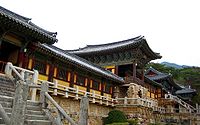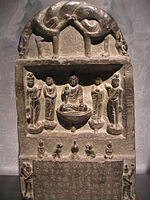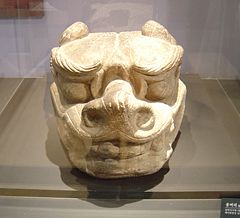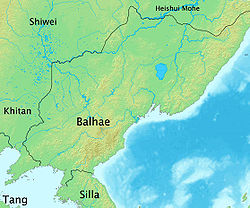- Balhae
-
- Alternate meaning: Bohai Sea
Balhae
발해(渤海)← 
698–926  →
→
 →
→
 →
→Balhae at its greatest territorial extent Capital Dongmo mountain
(698-742)
Junggyeong
(742-756)
Sanggyeong
(756-785)
Donggyeong
(785-793)
Sanggyeong
(793-926)Language(s) Goguryeo language
(Part of Old Korean)Religion Buddhism, Confucianism, Taoism, Korean shamanism Government Monarchy Emperor - 698 - 719 Go - 719 - 737 Mu - 737 - 793 Mun - 818 - 830 Seon Historical era Ancient - Establishment 698 - Fall of Sanggyeong January 14, 926 Balhae Korean name Hangul 진, then 발해 Hanja 振, then 渤海 Revised Romanization Jin, then Barhae McCune-Reischauer Chin, then Parhae History of Korea 
This article is part of a seriesPrehistory Jeulmun period Mumun period Gojoseon ?–108 BCE Wiman Joseon 194 BCE–108 BCE Proto–Three Kingdoms 300–57 BCE Buyeo, Goguryeo, Okjeo, Dongye Jin state, Samhan (Ma, Byeon, Jin) Four Commanderies of Han Three Kingdoms 57 BCE–668 Goguryeo 37 BCE–668 Baekje 18 BCE–660 Silla 57 BCE–935 Gaya 42–562 North and South States 698–926 Unified Silla 668–935 Balhae 698–926 Later Three Kingdoms 892–936 Taebong, Hubaekje, Silla Goryeo Dynasty 918–1392 Joseon Dynasty 1392–1897 Korean Empire 1897–1910 Colonial Korea 1910–1945 Provisional Gov't 1919–1948 Division of Korea 1945–present North, South Korea 1948–present By topic Timeline List of monarchs Linguistic history Science and technology history Art history Military history Naval history
Korea Portal
History of Manchuria Not based on timeline Early tribes Gojoseon Yan (state) Han Dynasty | Xiongnu Donghu | Wiman Joseon Wuhuan | Sushen | Buyeo | Okjeo Xianbei Cao Wei Jin Dynasty (265–420) Yuwen Former Yan Former Qin Later Yan Goguryeo Balhae (Bohai) Northern Yan Mohe | Shiwei Khitan | Kumo Xi Northern Wei Tang Dynasty Liao Dynasty Jin Dynasty (1115-1234) Yuan Dynasty Ming Dynasty Qing Dynasty Far Eastern Republic Green Ukraine Republic of China Soviet Union Manchukuo China (Northeast China) Russia (Russian Far East) Balhae (698 – 926) (Korean pronunciation: [paɾɦɛ], Bohai [渤海] in Chinese, Бохай in Russian) was a Korean kingdom established after the fall of Goguryeo that existed during the North South states period of Korea along with Unified Silla. After Goguryeo's capital and southern territories fell to Unified Silla, Dae Jo-yeong, a former Goguryeo general, whose father was Dae Jung-sang, established Jin (振, Zhen in Chinese), later called Balhae. It was a successor state to Goguryeo.
Balhae occupied southern parts of Manchuria (Northeast China) and Primorsky Krai, and the northern part of the Korean peninsula. It was defeated by the Khitans in 926, and most of its northern territories were absorbed into the Liao Dynasty while the southern parts were absorbed into Goryeo.
Contents
History
Founding
The earliest extant recorded mention of Balhae come from the Book of Tang, which was compiled between 941 to 945. Southern Manchuria and northern Korea were previously the territory of Goguryeo, one of the Three Kingdoms of Korea. Goguryeo fell to the allied forces of Silla and the Tang Dynasty in 668. The Tang annexed much of western Manchuria, while Silla unified the Korean peninsula south of the Taedong River and became Unified Silla. In the New Book of Tang, it was recorded that the founder of Balhae, Dae Joyeong (大祚榮) was a former Goguryeo general.
Expansion and foreign relations
The second King Mu (r. 719-737), who felt encircled by Tang, Silla and Black Water Mohe along the Amur River, attacked Tang with his navy in 732 and successfully attacked and killed a Tang prefect based on the Shandong Peninsula.[1] Later, a compromise was forged between Tang and Balhae, which resumed tributary missions to Tang. He also sent a mission to Japan in 728 to threaten Silla from the southeast. Balhae kept diplomatic and commercial contacts with Japan until the end of the kingdom. Balhae dispatched envoys to Japan 34 times, while Japan sent envoys to Balhae only 13 times.[2] Because of its proximity to many powerful states, Balhae became a buffer zone for the region.
The third Emperor Mun (r. 737-793) expanded its territory into the Amur valley in the north and the Liaodong Peninsula in the west. During his reign, a trade route with Silla, called "Sillado" (신라도, 新羅道), was established. King Mun moved the capital of Balhae several times. He also established Sanggyeong, the permanent capital near Lake Jingpo in the south of today's Heilongjiang province around 755; stabilizing and strengthening central rule over various ethnic tribes in his realm, which was expanded temporarily. He also authorized the creation of the Jujagam (胄子監), the national academy, based on the national academy of Tang. Although China recognized him as a king, Balhae itself referred to him as the son of heaven and an emperor.[3]
The tenth King Seon reign (r. 818-830), Balhae controlled northern Korea, Northeastern Manchuria and now Primorsky Krai of Russia. King Seon led campaigns that resulted in the absorbing of many northern Mohe tribes and southwest Lesser Goguryeo kingdom, which was located in the Liaodong Peninsula, was absorbed into Balhae. Its strength was such that Silla was forced to build a northern wall in 721 as well as maintain active defences along the common border.
Fall and legacy
 Stele from Balhae at the National Museum of Korea.
Stele from Balhae at the National Museum of Korea.
Traditionally, historians believed that ethnic conflicts between the ruling Koreans and underclass Mohe weakened the state.[4] Recent study suggests that the downfall of Balhae is largely due to the catastrophic eruption in the 10th century of Baekdu Mountain located at the center of Balhae territory. Baekdu mountain still has one of the biggest volcanic calderas in the world, Heaven Lake. Ashes of this eruption can still be found in a large area, even in a sedimentary layer in northern Japan. This massive explosion created tremendous amounts of volcanic ash, damaging agriculture and even societal integrity. The Khitans took advantage of this natural disaster.
Eventually, Balhae would succumb to the Khitans, an emerging power in the Liaoxi area (east of the current Beijing area). After destroying Balhae in 926, the Khitan established the puppet Dongdan Kingdom, which was soon annexed by Liao in 936. Some Balhae aristocrats were moved to Liaoyang but Balhae's eastern territory remained politically independent. Some Balhae people including aristocrats (est. 1 million), led by the last Crown Prince Dae Gwang-hyeon, fled southward to Goryeo, the new self-proclaimed successor of Goguryeo (934). Many descendants of the Balhae royal family in Goryeo changed their family name to Tae (태, 太) while Crown Prince Dae Gwang-hyeon was given the family name Wang (왕, 王), the royal family name of the Goryeo dynasty. Balhae was the last state in Korean history to hold any significant territory in Manchuria, although later Korean dynasties would continue to regard themselves as successors of Goguryeo and Balhae. Moreover that was the beginning of the northern expansion of later Korean dynasties.
The Khitans themselves eventually succumbed to the Jurchen people, who founded the Jin Dynasty. The Jin dynasty favored the Balhae people as well as the Khitans. Jurchen proclamations emphasized the common descent of the Balhae and Jurchen people from the seven Wuji (勿吉) tribes, and proclaimed "Jurchen and Balhae are from the same family". The fourth, fifth and seventh emperors of Jin were mothered by Balhae consorts. The 13th century census of Northern China by the Mongols distinguished Balhae from other ethnic groups such as Goryeo, Khitan and Jurchen. This suggests that the Balhae people still preserved their identity even after the conquest of the kingdom.
Aftermath
After the fall of Balhae and its last king in 926, it was renamed Dongdan by its new Khitan rulers,[5] who had control over most of Balhae's old territories. However, starting from 927, many rebellions were triggered throughout the domains. These rebellions were eventually turned into several Balhae revivals. Out of these, only three succeeded and established kingdoms: Later Balhae, Jeong-an kingdom, Heung-yo kingdom and Daewon kingdom. These three kingdoms were able to temporarily chase the Khitan and their Dongdan Kingdom out into the Liaodong peninsula,[citation needed] but they were all eventually devastated by the Liao Empire.
In 934, Dae Gwang-hyeon, the last Crown Prince of Balhae, revolted against the Khitans. After being defeated, he fled to Goryeo, where he was granted protection and the imperial surname. This resulted in the Liao breaking off diplomatic relations with Goryeo, but there was no threat of invasion.[6]
Government and culture
Balhae was made up of former Goguryeo remnants and of several Tungusic peoples present in Manchuria, of which the native Mohe made up the largest. The Mohe constituted as subject people, some forced into slave status into serving the Goguryeo ruling class.[4] As such, they made the bulk of the labor class. Nevertheless, there were instances of Mohe moving upward into the Balhae elite, however few, such as the followers of Geolsa Biu, who supported the estalblishment of Balhae. They were limited to the title of "suryong", or "chief", and played a part in the ruling elite. Although rare, some members of Balhae embassies held Mohe surnames.
Because all written records from Balhae itself have been lost, all information concerning the kingdom must be gained from archaeological excavation and contemporary Chinese accounts. After its founding, Balhae actively imported aspects of the culture and political system of Tang Dynasty China. Archaeologists studying the layout of Balhae's cities have conclude that Balhae cities shared features common with cities in Goguryeo, indicating that Balhae retained cultural similarities with Korea after its founding.[7] According to Chinese accounts, Balhae had five capitals, fifteen provinces, and sixty-three counties.[8]
It is noted that Balhae was a culturally advanced society, as an official from China described it as the "flourishing land of the East." The government operated three chancelleries and six ministries. It is obvious that Balhae's structure was modelled after the Chinese system, however it did not entirely conform to that of the Tang. The "taenaesang" or the "great minister of the court" was superior to the other two chancelleries (the left and the right) and its system of five capitals originates from Goguryeo's administrative structure. Balhae, like Silla, sent many students to Tang to study, and many went on to take and pass the Chinese civil service examinations.([1][2]) As consequence, the Balhae capital of Sanggyong was organized in the way of Tang's capital of Chang'an. Residential sectors were laid out on either side of the palace surrounded by a rectangular wall.
The principal roots of Balhae culture was that of Goguryeo origins. An Ondol installation was uncovered in the inner citidel of the Balhae palace and many others adjacent to it. Furthermore, Buddhist statuaries and motifs were found in Balhae temples that reflect that of distinctive Goguryeo art. An important source of cultural information on Balhae was discovered at the end of the 20th century at the Ancient Tombs at Longtou Mountain, especially the Mausoleum of Princess Jeong-Hyo.
Characterization and political interpretation
Controversy rests over the ethnic makeup of the people of Balhae. That Balhae was founded by a former general from Goguryeo is undisputed, but there is some dispute over his ethnicity, due to ambiguous wording in historical sources. No written records from Balhae itself survive.
Koreans have regarded Balhae as a Korean state, particularly from the Joseon Dynasty onwards. The 18th century, during the Joseon Dynasty, was a period in which Korean scholars began a renewed interest in Balhae. The Qing and Joseon dynasties had negotiated and demarcated the Sino-Korean border along the Yalu and Tumen rivers in 1712, and Jang Ji-yeon (1762–1836), journalist, writer of nationalist tracts, and organizer of nationalist societies, published numerous articles arguing that had the Joseon officials considered Balhae part of their territory, they would not be as eager to "give up" lands north of the rivers. Yu Deuk-gong in his eighteenth-century work Balhaego (An investigation of Balhae) argued that Balhae should be included as part of Korean history, and that doing so would justify territorial claims on Manchuria. Korean historian Sin Chae-ho, writing about Jiandao in the early twentieth century, bemoaned that for centuries, Korean people in their “hearts and eyes considered only the land south of the Yalu River as their home” and that “half of our ancestor Dangun's ancient lands have been lost for over nine hundred years.” Sin also criticized Kim Busik, author of the Samguk Sagi, for excluding Balhae from his historical work and claiming that Silla had achieved unification of Korea.[9] Inspired by ideas of Social Darwinism, Sin wrote:
- "How intimate is the connection between Korea and Manchuria? When the Korean race obtains Manchuria, the Korean race is strong and prosperous. When another race obtains Manchuria, the Korean race is inferior and recedes. Moreover, when in the possession of another race, if that race is the northern race, then Korea enters that northern race's sphere of power. If an eastern race obtains Manchuria, then Korea enters that race's sphere of power. Alas! This is an iron rule that has not changed for four thousand years."[10]
Neither Silla nor the later Goryeo wrote an official history for Balhae, and some modern scholars argue that had they done so, Koreans might have had a stronger claim to Balhae's history and territory. [3]
In modern North and South Korea, Balhae is regarded as a Korean state and is positioned in the "North South States Period" (with Silla) today, although such a view has had proponents in the past. They emphasize its connection with Goguryeo and minimize that with the Mohe. While South Korean historians think the ethnicity ruling class was of Goguryeo and the commoners were mixed, including Mohe, North Korean historians think Balhae ethnography was mostly Goguryeo. Koreans believe the founder Dae Joyeong was of Goguryeo stock. The Book of Tang says that Dae Joyeong was a "Goguryeo variant" (고려별종, 高麗別種),[4] and the New Book of Tang states that he is "from the Sumo Mohe region of the former realm of Goguryeo."
In the West, Balhae is generally characterized as a successor to Goguryeo that traded with China and Japan, and its name is romanized from Korean.[dubious ] [5] [6] [7] [8] Romanization from Chinese, as "Bohai", is also common in English.[7][11][12][13] It is seen as composed of peoples of northern Manchuria and northern Korea, with its founder and the ruling class consisting largely of the former aristocrats of Goguryo. Korean scholars believe Balhae founder Dae Joyeong was of Goguryeo ethnicity, while others believe he was an ethnic Mohe from Goguryeo. [9] [10][11] [12] [13] [14]
 A dragon head artifact from Balhae at the National Museum of Korea.
A dragon head artifact from Balhae at the National Museum of Korea.
Like many ancient Korean kingdoms and other states, Balhae sometimes paid tribute to China,[citation needed] and an heir who lacks this sanction was called by China 知國務 ("State Affairs Leader"), not king; also, China considered every king simultaneously the Prefect of Holhan Prefecture (忽汗州都督府都督).[citation needed] However, Balhae rulers called themselves emperors and declared their own era names.
Chinese historians insist Balhae to be composed of the Balhae ethnic group, which was mostly based on the Mohe. Historically, the Jurchens (later renamed the Manchus, considered themselves as sharing ancestry with the Mohe. According to the Book of Jin (金史), the history of the Jurchen Jin Dynasty, the Jurchens proclaimed "The Jurchens and Balhae are from the same family". (女直渤海本同一家)[14] The People's Republic of China continues to consider Balhae as part of the history of its ethnic Manchus. [15]
The People's Republic of China is accused of limiting Korean archealogists access to historical sites located within Liaoning and Jilin. Starting from 1994, increasing numbers of South Korean tourists began to visit archaeological sites in China and often engaged in nationalistic displays. This was aggravated by a series of tomb robberies and vandalism at several of these archaeological sites between 1995 and 2000, which were widely believed to have been perpetrated by ethnic Koreans.[15]
South Korean archeologist Song Ki-ho, who is a noted professor of Seoul National University and has published several papers criticizing the Chinese government, made several visits to China in the 1990s, 2000, 2003, and 2004, examined several historical sites and museums. However, he found himself restricted by limitations on note-taking and photography and even ejected from several sites by museum employees.[16][17][18]
North Korea has restricted independent archaeologists from its historical sites, many of which may be Balhae-related, since at least the early 1960s. Foreign scholars have criticized political bias in North Korean historiography, and have accused North Korean scholars of reconstructing or even fabricating historical sites.[19]
Scholars from South and North Korea, Russia and Japan assert that Balhae was independent in its relations with the Tang Dynasty. Most Russian archaeologists and scholars describe Balhae as a kingdom of displaced Goguryo people.[19]ru:Пархэ[16] They do admit that Balhae had a strong Chinese and Central Asian influence. [17]
In relations with Japan, Balhae referred to itself as Goguryeo, and Japan welcomed this as a kind of restoration of its former friendly relationship with Goguryeo. [18] [19]
Media
Balhae is mentioned in a Korean film called Shadowless Sword, which is about the last prince of Balhae. Also in a Korean TV drama, which started in September 2006, featured the founder of Balhae Dae Jo Yeong. Currently the series has completed airing.
See also
- Ancient Tombs at Longtou Mountain
- Goguryeo
- History of Korea
- List of Korea-related topics
- List of Provinces of Balhae
- List of rulers of Balhae
- Mausoleum of Princess Jeonghyo
- Mohe
- North South States Period
References
- ^ Zizhi Tongjian, vol. 213.
- ^ 9 Balhae and Japan Northeast Asian History Foundation
- ^ 야청도의성(夜聽도衣聲)
- ^ a b Lee Ki-baik. "The Society and Culture of Parhae." The New History of Korea, page 88-89. Harvard University Press, 1984.
- ^ [Mote p. 49]
- ^ [Mote p. 62]
- ^ a b Ogata, Noboru. "A Study of the City Planning System of the Ancient Bohai State Using Satellite Photos (Summary)". Jinbun Chiri. Vol.52, No.2. 2000. pp.129 - 148. Retrieved November 10 2011.
- ^ Ogata, Noboru. "Shangjing Longquanfu, the Capital of the Bohai (Parhae) State". Kyoto University. January 12 2007. Retrieved November 10 2011.
- ^ Andre Schmid (2000). "Looking North toward Manchuria". The South Atlantic Quarterly 99 (1): 219–240. doi:10.1215/00382876-99-1-219. http://muse.jhu.edu/journals/south_atlantic_quarterly/v099/99.1schmid.html.
- ^ Andre Schmid (1997). "Rediscovering Manchuria: Sin Ch'aeho and the Politics of Territorial History in Korea" (– Scholar search). The Journal of Asian Studies 56 (1): 30. JSTOR 00219118.[dead link] Sin was criticizing previous generations of Korean historians, who had traced Korean history back to the ancient peoples of the Korean peninsula. Sin believed that by doing so, and regarding "minor peoples" as their ancestors, they were diluting and weakening the Korean people and their history. He believed that the Korean race was in fact mainly descended from northern peoples, such as Buyeo, Goguryeo, and Balhae, and (re)claiming such a heritage would make them strong.
- ^ Kim, Alexander. "The Historiography of Bohai in Russia". The Historian. Vol.73, Issue 2. pp 284–299. June 8 2011. Retrieved November 10 2011
- ^ Pike, John. "Balhae / Bohai - 698AD-926AD". Globalsecurity.org. November 7 2011. Retrieved November 10 2011.
- ^ "Parhae". Encyclopedia Britannica Online Academic Edition. 2011. Retrieved November 10 2011.
- ^ Book of Jin (金史)
- ^ Mark Byington (2004). The War of Words Between South Korea and China Over An Ancient Kingdom: Why Both Sides Are Misguided. http://hnn.us/articles/7077.html.
- ^ Terrill, Ross (2004-08-03). The new Chinese empire: And what it means for the United States. ISBN 9780465084135. http://books.google.com/?id=1yU6nMPALMwC&dq=parhae&lpg=PA198&pg=PA199.
- ^ Terrill, Ross (2004-08-03). The new Chinese empire: And what it means for the United States. ISBN 9780465084135. http://books.google.com/?id=1yU6nMPALMwC&dq=parhae&lpg=PA198&pg=PA198.
- ^ http://review.aks.ac.kr/AttachedFiles/05-Song%20Ki-ho.pdf
- ^ a b Leonid A. Petrov (2004). "Restoring the Glorious Past: North Korean Juche Historiography and Goguryeo". The Review of Korean Studies 7 (3): 231–252.
- Mark Byington (October 7–8, 2004). "“A Matter of Territorial Security: Chinese Historiographical Treatment of Koguryo in the Twentieth Century”". International Conference on Nationalism and Textbooks in Asia and Europe, Seoul, The Academy of Korean Studies..
- 孫玉良(1992). 渤海史料全編. 吉林文史出版社 ISBN 978-7-80528-597-9
Work Cited
F.W. Mote (1999). Imperial China, 900-1800. Harvard University Press. pp. 49, 61–62. ISBN 0674012127.
External links
- Encyclopedia Britannica
- Britannica Concise Encyclopedia
- the state of Parhae (or Bohai in Chinese) from The Encyclopedia of World History Sixth Edition, Peter N. Stearns (general editor), © 2001 The Houghton Mifflin Company, at Bartleby.com.
- Columbia Encyclopedia
- U.S. Library of Congress: Country Studies
- Metropolitan Museum of Art
- (Korean)Provinces of Balhae Kingdom in 820
- (Korean) RootsInfo.co.kr
- (Korean) Balhae creation and it's Extension
- (Korean) Han's Palhae of Korea 한규철의 발해사 연구실
Categories:- Former monarchies
- Former countries in East Asia
- States and territories established in 698
- States and territories disestablished in 926
- 926 disestablishments
- Balhae
- Former countries in Korean history
- 690s establishments
- 920s disestablishments
- Former empires
Wikimedia Foundation. 2010.

